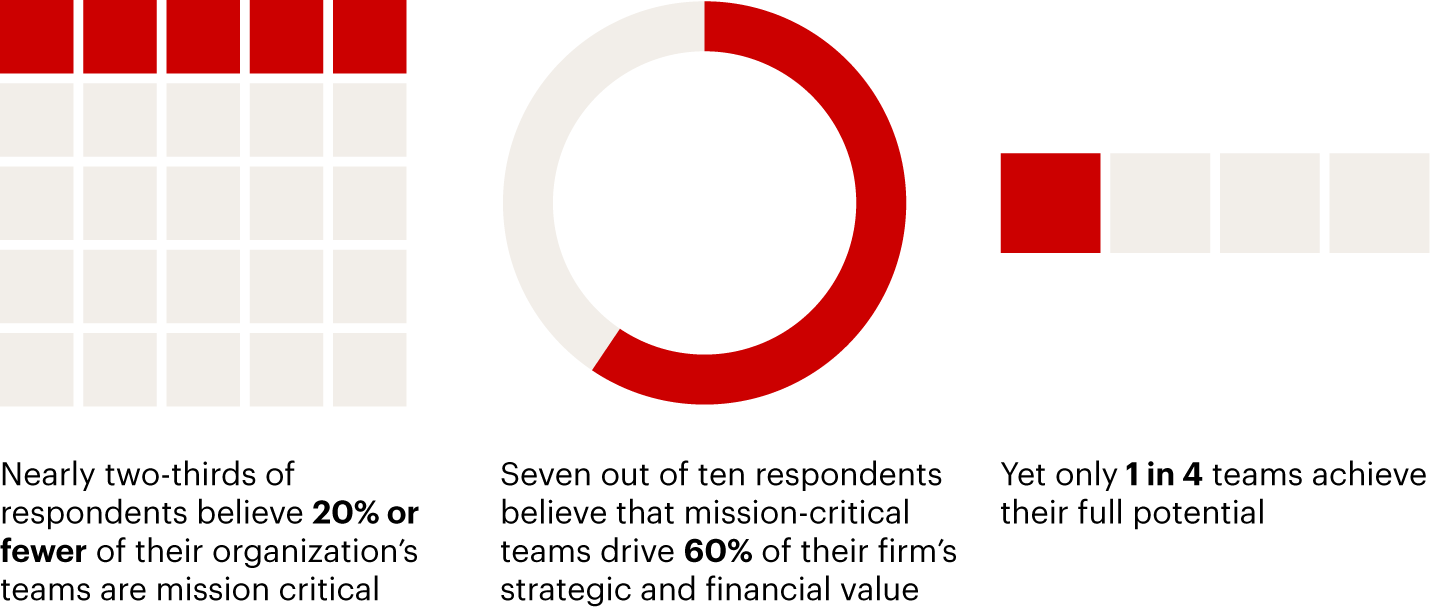Brief

In evidenza
- Just 20% of pharma teams generate 60% of a company’s strategic and financial value—yet only one in four of those teams reaches its full potential, Bain research finds.
- Poor mission alignment is the biggest barrier to such teams’ success, according to 71% of pharma executives.
- One company transformed a struggling program by clarifying a critical team’s mission and focusing on a few “must-win” outcomes.
High-performing teams are important in every industry, but in pharmaceuticals they are critical. Just 20% of pharmaceutical teams drive 60% of a company’s strategic and financial value, but only one in four achieves its full potential (see Figure 1).


Pharmaceutical companies are primarily organized by function, but drug development and commercialization depend on integrated, cross-functional execution. Mission-critical teams bring together experts from across the organization to deliver shared outcomes no single function could achieve alone. To succeed, these teams must operate across silos. Yet members typically report to their functional leads—not the team leader—and their goals often diverge.
The complexity of pharma compounds these challenges. Regulatory requirements, compliance, safety, quality, and cost considerations often compete. As a result, decision making and execution can be slow.
Mission-critical teams must overcome these challenges.
Companies with strong mission-critical teams start by defining the team’s mission in terms of shared outcomes—results no single function could produce alone. This often involves navigating critical trade-offs: cost vs. speed, speed vs. power of a study, or the trade-offs required when testing multiple potential indications for a single asset.
That was the challenge faced by a mid-sized pharmaceutical company as it advanced a complex development program for multiple indications of a high-priority asset.
The company quickly assembled a core team, assigning its best available talent. As managers added missing capabilities, the team doubled in size. Soon, it began to miss deadlines.
A root cause assessment, including surveys of team members and executives, revealed the central issue: Leaders had not clearly communicated the shared outcomes expected of that team. Without clarity, the team struggled to prioritize and make trade-offs. When they asked for guidance, leaders stepped in to help, but this created a sense of ad hoc management and limited team autonomy. Team members did not understand which outcomes were “must win.”
Management took three steps in response. First, they brought the full team together to reiterate the mission, priority objectives, and shared outcomes. They helped the team focus on three must-win battles, out of dozens of competing priorities. Second, they rapidly identified talent gaps and acquired new talent with the needed capabilities. These steps enabled the team to streamline its structure and focus on priority indications. Finally, the executive team created a formal mechanism to engage with the team and provide sustained support, ensuring the team had access to their input and the practical help needed to move quickly.
This helped the company submit its application for the new molecule’s first indication and accelerated multiple follow-on indications. Confidence in the team climbed quickly, and the team itself is reenergized and pushing new ways to accelerate progress.
Three ways to accelerate mission-critical teams
No two companies will approach mission-critical teams in exactly the same way, but three practices consistently make a difference.
- Clarify the mission. Unclear mission alignment is the biggest barrier to success, according to 71% of pharma executives recently surveyed (see Figure 2). To operate effectively, teams need to understand:
• why they are doing this work—the vision and asset mission;
• what they must do to achieve the mission, objectives, and the shared outcomes unique to that team; and
• how they will do it—the process, ways of working, structure, and the necessary capabilities and capacity to do the work required.
Figure 2The five elements that give the greatest boost to mission-critical team performance Source: Bain Mission-Critical Teams Pharma Survey, November 2024 (n=150) - Adjust governance and process to match scale. Small and large companies diverge in important ways on governance and process, our research shows. Small companies are often collaborative and agile. They move fast but can lack the specialized expertise, experience, and resources to deliver their objectives. Their mission-critical teams benefit from greater structure, metrics, and planning.
Large firms, with systems and governance designed for scale and repeatability, can be bureaucratic. This slows decisions and hinders team effectiveness. Senior leaders of big companies need to strip away red tape and help their teams move faster. This often requires a shift in mindset from “it’s the team’s job to succeed” to “it’s my job to understand and provide the support and resources the team needs and remove any obstacles.” - Align on what matters. Our research shows that leaders, managers, and team members have different priorities. Team members value shared ownership of outcomes, managers focus on capacity, and leaders prioritize collaboration. The first step is agreeing on the most important problems to solve. Then, leaders must enable success—by adding resources, clarifying outcomes, or signaling to other parts of the organization that the mission-critical team is a top priority.
The mid-sized company succeeded because its leaders dug into the root causes of the challenges facing its mission-critical team and gave the team the support it needed. Team leaders communicated more effectively and adapted how they managed the team, while team members focused on their critical priorities. When all levels of the organization align, mission-critical teams don’t just deliver—they elevate what’s possible.